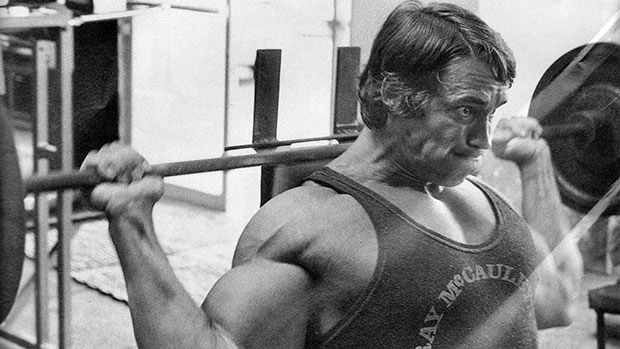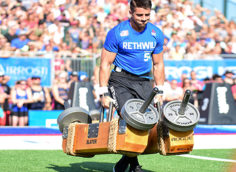Lead Image Photo Credit: Brandon Mui, RX Photography
Lifters love to add a little novelty to their training. But advanced lifters know that too much variability and too many "fluff exercises" can take away from their gains.
The fix? Keep your focus on the big six – the six foundational movement patterns, that is – but add some variety within those patterns. As a refresher, the big six are:
- Squatting
- Hip-hinging
- Pushing
- Pulling (both vertically and horizontally)
- Lunging
- Carrying
Just keep these guidelines in mind when planning your workouts:
- Make the six movement patterns the base of your workouts and program design.
- Sprinkle in a variety of assistance exercises and change them out every 2-3 weeks.
- Isolation exercises are still fine. You can focus on singular muscles, but don't let them crowd out your big six.
The Big Six Variations
You've got a ton of choices, but here are the ones I recommend that you're probably not doing.
The box squat separates the concentric and eccentric phases of the lift making them far easier to recover from while still achieving the same cumulative training effects. It also reinforces good motor patterns. You can use it as a speed-strength measure or a maximal strength measure.
If you've mastered the box squat already, adding bands that pull from the front will be a "nice" change.
This is considered to be reactive neuromuscular training (RNT). It increases the demand across the whole front side of your body. Your ability to brace through dynamic movement is paramount.
Bands turn a simple lift into more of a stability challenge, so you can still reap the same benefits of the box squat while adding a bit of novelty.
The trap bar completely changes the position of the load, bringing it closer to your center of mass. This creates a different gravity line. This variation is much more lower-back friendly than a traditional deadlift.
Add reverse bands to the mix and you effectively increase loading capacity while NOT losing the ability to refine your hip-hinge pattern. In fact, most equate reverse band use with supramaximal loading, and this certainly can be one advantage when used for true max-effort work. More important though, reverse bands allow for better mechanics even with less familiar loads.
For this reason, I prefer to use reverse bands in a submaximal setting with sets of 3-6 reps.
The push-up is about as foundational as it gets for a pushing pattern, but it's often butchered or half-repped. Hopefully you're doing legitimate full-range chest to floor push-ups.
If you can do numerous full ROM reps and you're ready for a challenge, add resistance and a bit of oscillatory motion. By using a neutral-grip bar either on a rack or the floor you'll increase the amount of stability required. By adding more loading (in this case with a weight vest) you'll change the training stimulus and make the push-up less of a pure endurance-based movement.
The pull-up is the king of all bodyweight movements. If you've already gotten it down, then you've got some options. A less known one? The contrast method.
Secure a dumbbell between your feet and hit three reps, then release the dumbbell and crank out 3-5 more strict reps. The contrast of additional weight to bodyweight provides a neuromuscular component allowing you to feel like you can perform more strict reps.
The level of difficulty of holding a dumbbell between your feet places more demand on the core than a standard dip-belt weighted pull-up.
4.5 Horizontal Pull – Crank up the Volume
We're still on pulling because you'll need both a vertical and horizontal pull... plus everyone knows rows are required for a big, strong back.
This variation is perfect as a high-volume finisher. So grab a heavy band and an incline bench. Attach your band in the rack at the lowest point. While this variation is challenging, aim higher than 8-12 reps per set. Think more like 25-plus reps per set.
Try adding isometric holds too. Do 10 explosive reps, then a 10 second hold. Go for 3 sets. If you use a strong enough band this should sting!
The rear foot elevated split squat (RFESS) is quite possibly one of the most well-known and highly regarded single-leg exercises.
Add a barbell in the front rack position and not only do you have an increased level of difficulty, but you've also increased loading capacity compared to what you'd get holding dumbbells in your hands.
If you've got one, try a Safety Squat bar which, while it's not mandatory, provides a different challenge than a standard straight bar.
This variation works well for both speed sets (lighter loads of 3 explosive reps per leg), submaximal sets of 5-6 reps per leg, or straight hypertrophy work for 8-12 reps per set.
Loading up and taking a walk is a surprisingly effective tool in both strength and conditioning scenarios.
The front rack carry is relatively easy to get into position. If you can take it outside to avoid hitting people with your bar, even better.
Try using heavier loads for shorter distances for a strength emphasis. Do 4-6 sets of 20-30 yards.
One caveat: Hold the barbell with arms crossed (bodybuilder style) since walking in a true front rack position could be uncomfortable and stressful for the forearm extensors.




